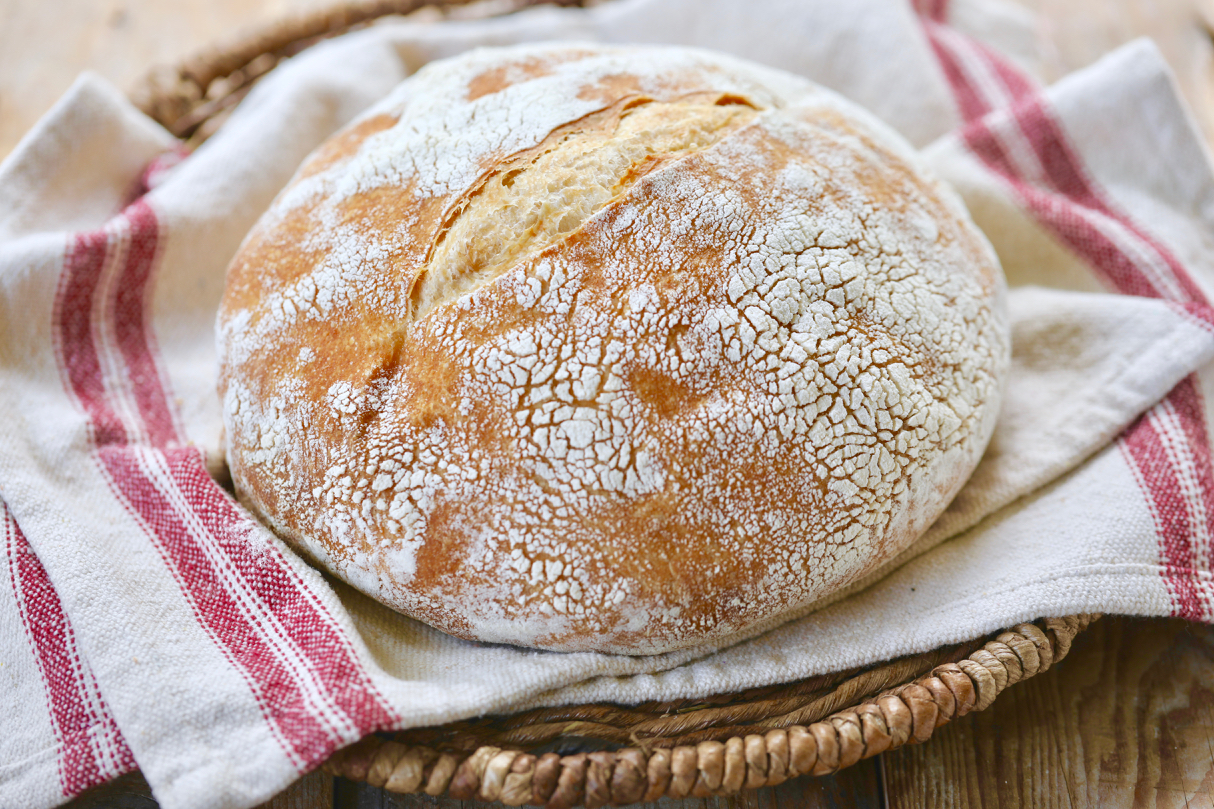
This post may contain affiliate links. Please see my full disclosure for details.
Hi Bold Bakers!
Not in a million years did I ever think I would be able to bake a loaf of sourdough bread from my very own starter that I didn’t kill already! Yes, I have been a professional chef for 15 + years BUT sourdough was not a specialty of mine, and I wasn’t personally in charge of feeding and sustaining a sourdough starter at any of my previous jobs, so really this is new territory for me.
With this recipe, I kept it real simple. The reason being is that sourdough can be intimidating and I wanted to set you (and myself) up for success. We will begin here, hone our skills, and progress onto Bigger and Bolder sourdough bread down the road. For now, though, I’m going to teach you how to make the easiest sourdough bread loaf in the world.
Want to level up your sourdough baking? Check out the internet’s MOST detailed and thorough Sourdough Q&A that myself and my team of sourdough experts created with hundreds of your questions and answers that we have received.
[ Make Sourdough Pizza, Too! ]
What is Sourdough Bread?
Sourdough bread is a bread dough leavened using naturally occurring yeast from the atmosphere (also known as a sourdough starter). What’s a starter you might ask? A sourdough starter is a live culture of flour and water, and you can find all about it in the last sourdough starter guide you’ll ever need.
Once combined, the culture will begin to ferment which cultivates the natural yeasts found in our environment. A small portion is added to your bread dough to make it rise. Commercial yeast IS NOT required, although you will see it used in some recipes.
Some of the characteristics of Sourdough bread are its sour taste and also its lovely bubbly crumb.
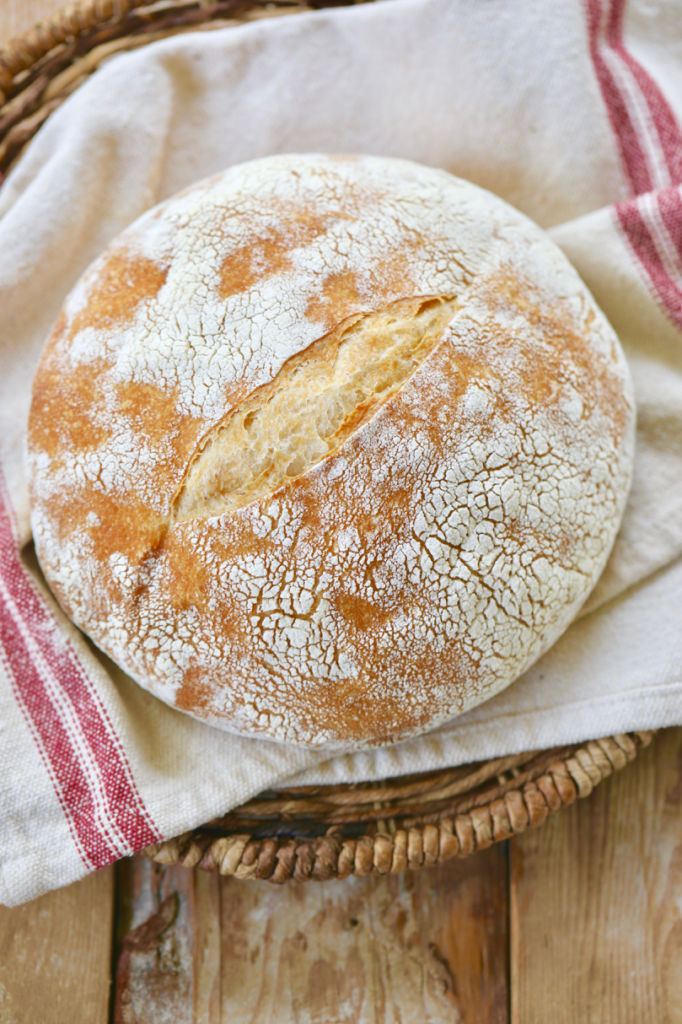
What Makes This Sourdough “For Beginners”
The answer is simple and that I myself am a beginner when it comes to sourdough. Truth be told I have only made a total of 4 loaves in my life (including the bread pictured). Each time I’m improving, and I know I have a huge amount to learn regarding technique, but for right now this is where I’m starting.
I built this sourdough recipe from the ground up because I found it really hard to follow the majority of recipes online. Too many steps for my liking as a simple baker. So, I did what I always do with recipes: I stripped away all the fluffy stuff and kept it bare bones. So whether you are a novice (like me), or a frequent bread baker, you will really enjoy this recipe and the results.
How Much Sourdough Starter Do I Need?
That really depends on the recipe as they are all different. Mine calls for 1/2 cup (4oz/115g) of my sourdough starter for a nice boule of sourdough bread. Just note that if you try a few different sourdough bread recipes from different sources, you CAN use my sourdough starter in any of them as long as you follow the amount their recipe indicates!
Get my sourdough starter guide.
What You Need To Make Sourdough Bread
You will be happy to know that although this is a classically more involved method of bread making you don’t need any fancy equipment. All you need is:
- Weighing scales (optional)
- Large mixing bowl
- Measuring jug
- Measuring spoons
- Spatula
- Bowl/basket for proofing
- Large metal oven-proof bowl or 18/10 Stainless Steel pot with SS handles, for steaming (optional)
- Clean dish towel
- 2 Baking Trays
How to Make Sourdough Bread
Making the dough:
- In a large bowl mix your starter, water, and olive oil together.
- Add the flour and salt and mix together by hand.
- Form a ball of dough with your hand that cleans the bottom of the bowl.
- Place the dough in a greased bowl and all to ferment. Cover with cling wrap and a dishtowel.
Bulk Fermentation:
- Proof your dough for roughly 12-18 hours at room temperature. I mix mine up the night before and let it proof overnight.
- Remove the dough from the bowl and place it on a floured surface and fold the dough over itself’s to strengthen it.
Shape and Proof your dough:
- On a flourless surface, shape the dough into a boule by pushing the dough against your surface to make it round and smooth.
- In a bowl or proofing basket, lay a kitchen towel that has been dusted generously with flour.
- Place your dough into the bowl with the seams facing you and the smooth side down.
Proofing the Sourdough:
- Proof the dough for roughly 1 ¾ -2 ½ hours or until the bread has risen to almost double the size. Once the dough is well risen and feels almost lighter and not as heavy then it’s time to bake it off.
Baking the Sourdough:
- Preheat your oven to 450°F (225°C) and a baking pan. Gently turn the dough out onto a separate floured flat baking tray (not preheated). Carefully make it round again pushing the seams underneath.
- Score the bread on top with any design you like.
- Turn down the oven to 400°F (200°C) and slide your bread from your floured tray onto your preheated tray.
- Bake for roughly 55-65 minutes or until a gorgeous golden brown color. (See notes in the written recipe about creating steam)
- Cool the bread completely before cutting. CONGRATS! You just made a loaf of sourdough bread from scratch.
Gemma’s Pro Chef Tips to Sourdough Bread
- I recommend bread flour and not all-purpose flour when making my sourdough. The extra gluten yields you a bubblier crumb and a chewier bread.
- Place a large metal bowl, which must be oven proof, over your dough in the oven. The bowl will create steam around the bread and give you a chewier crust. Bake like this for the first 30 minutes.
- Bake your sourdough on a pre-heat tray to give your bread a crisp crust. It also aids in the oven spring.
- If your dough appears cold and sluggish then place it near a heat source like an oven that is cooling down.
- Refrain from opening the door too much while baking as to not let out the heat that will give you a crisp crust.
- Allow your bread to cool completely before cutting: I know it’s tempting but it is at its best when it has fully cooled.
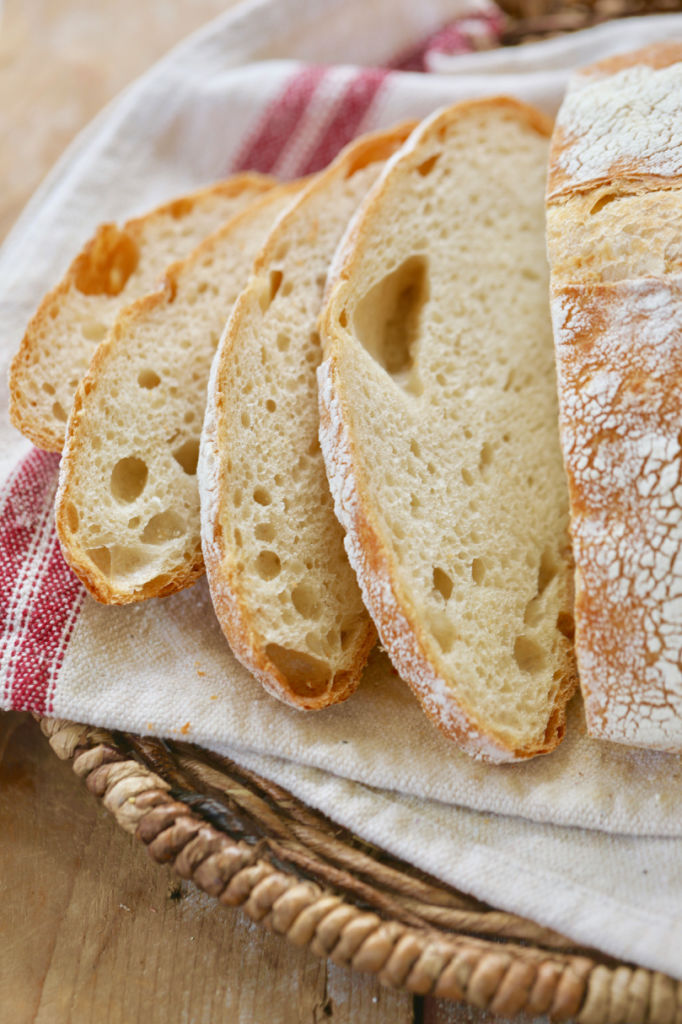
How do I store my Sourdough Bread?
Store your sourdough bread covered at room temperature for up to 3 days. It also freezes really well for up to 6 weeks. I slice my loaf and freeze it so I can just take out a slice at a time. Kidding, I take out 3 slices!
After that if it is stale you can cut the bread into chunks and process it in a food processor to make breadcrumbs.
Thanks to Emilie from The Clever Carrot. I followed her Sourdough Starter recipe and learned a lot about making a loaf of sourdough from her.
Get More Bread Recipes
Don’t forget to buy a copy of my Bigger Bolder Baking cookbook for even more recipes!
Watch The Recipe Video!
Perfectly Crusty Sourdough Bread Recipe For Beginners
Ingredients
- 1/2 cup (4oz/115g) sourdough starter (fed / active)
- 1 cup (8floz/225ml) lukewarm water
- 2 tablespoons olive oil
- 2 3/4 cups (14oz/389g) bread flour*
- 2 teaspoons salt
- Olive oil for greasing
Instructions
Making the Sourdough:
- In a large bowl, add in your sourdough starter, water, and olive oil and whisk to combine.
- Add the flour and salt and mix together using either a spatula or your hand. I prefer my hand so you can feel exactly how wet or dry your dough is.
- Bring your dough together to form a ball that cleans the bottom of the bowl. (If your dough is a little on the dry side add a splash more water).
- Remove the dough from the bowl and grease that bowl with a little olive oil. Place your dough back into the bowl and tightly cover with cling wrap and a dishtowel.
Bulk Fermentation:
- Set aside the dough to proof for roughly 12-18 hours. I mix mine up the night before and let it proof overnight. If you are unable to bake it off after this time place it in the fridge for up to 3 days.
- Carefully remove the dough from the bowl and place on a floured surface. I don’t knock out the air but rather I fold the dough over itself to strengthen it.
Shape and Proof your Sourdough:
- On a flourless surface, shape the dough into a boule or a ball by pushing the dough against your surface to make it round and smooth.
- Lay a kitchen towel in a bowl or breadbasket and dust it generously with flour.
- Place your dough into the bowl with the seams facing you and the smooth side down. Cover over with the towel so that none of the dough is exposed to the air. (Air is not a doughs friend so keep it well covered so it doesn’t form a skin)
Proofing the Sourdough:
- Proof the dough for roughly 1 ¾ -2 ½ hours or until the bread has risen to almost double the size. Don't rush this step, if your bread is not ready then give it the time it needs. Once the dough is well risen and feels almost lighter and not as dense then it’s time to bake it off.
Baking the Sourdough:
- Preheat your oven to 450°F (225°C) and place a tray on a lower shelf in the oven.
- Safely and carefully turn the dough out onto a different floured flat baking tray. Gently, shape it back into a round loaf with your hands by pushing the seams underneath the bread.
- Score the bread with a blade or a sharp knife. I cut it straight down the middle.
- Turn down the oven to 400°F (200°C) and slide your bread onto your preheated tray.
- Bake for 55-65 minutes or until a gorgeous golden brown color.
Creating Steam in the Oven:
- So this is optional, BUT, the introduction of steam during the baking process does make a big difference to the texture and color of your crust. You can do this by using a Dutch oven, an oven-proof metal bowl, or a cake pan with water.
Dutch Oven:
- Skip the proofing bowl and allow the dough to proof in the actual dutch oven for the time given above. Making sure to line it with parchment or dust with flour beforehand.
- Once risen and not as dense, bake your sourdough with the lid on for roughly 25-30 minutes. Remove the lid and continue to bake in the pot for the remaining time.
Large Metal Bowl:
- Place a large metal oven-proof bowl directly over the dough immediately as it goes into the oven. This bowl will create steam around your loaf. Carefully remove the metal bowl after 30 minutes and bake as normal for the remaining time. Tip: An 18/10 stainless steel pot with stainless steel handles will work well for this.
Cake Pan with Water:
- Place a cake pan or shallow baking tray in the oven with hot water to create steam for the bread giving it a nice color and chewier crust. Carefully remove the cake pan of water after 30 minutes and bake as normal for the remaining time.
- Once the crust is crisp, a deep golden brown and sounds hollow when tapped remove from the oven. Note: the crust softens once it cools so just note that you might think it got too crisp but a little later it will be softer.
- Allow cooling down completely before cutting your bread. It’s tempting, but don’t cut hot bread, it’s just not the same. Let it cool down for at least 2-3 hours before cutting.
- Store your sourdough covered at room temperature for up to 3 days. And CONGRATS! You just made a loaf of sourdough bread from scratch.
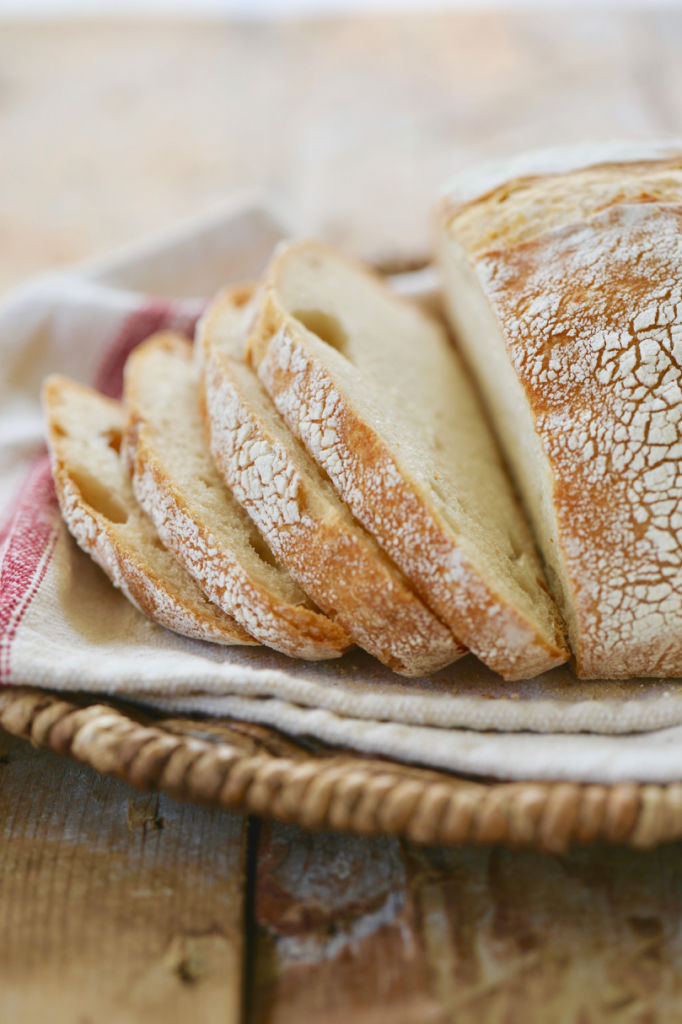

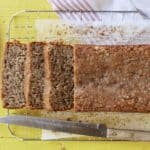
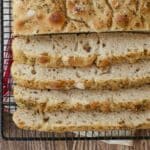
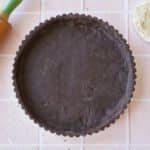
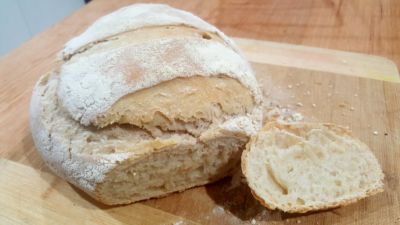
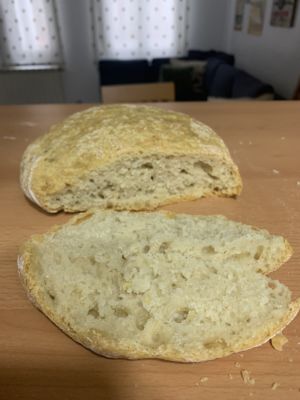
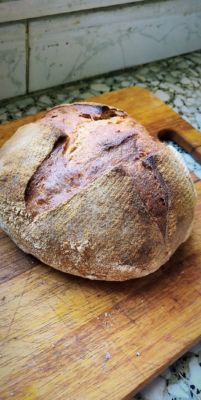
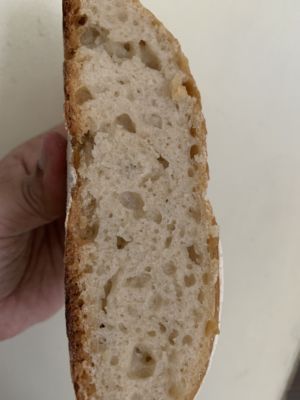
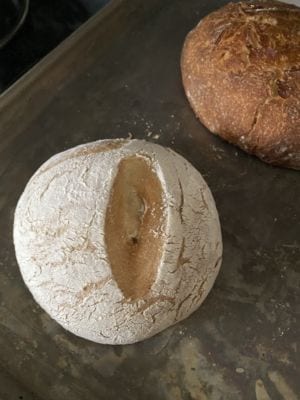
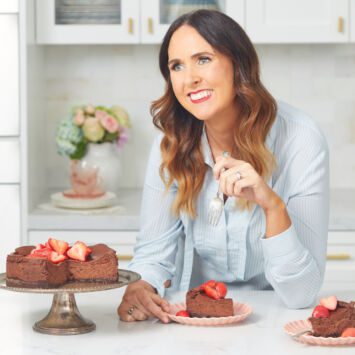


Hi Gemma, I hope you are doing well in these crazy times… Great to encourage people to make their own breads. Particularly now. I just wanted to add a tip to your Dutch Oven method. This is really the easiest way to get a wonderful crunchy crust but I would recommend heating the pot in the oven as it’s preheating and even letting it stay in a little longer before adding the bread. This gives you that “oven spring’ and helps create the perfect crumb as well. And no dusting of the pot is necessary when you do it like… Read more »
I spent awhile looking for sourdough recipes, and this one was by far the easiest to follow. I’m sure there are a lot of great recipes out there, but most of us don’t need a ten-page-dissertation. This article was just the right amount of information and our bread turned out great (we used the metal-bowl technique and used all-purpose flour with a great result). Tomorrow will be a “two-loaf” day!
Hi mam I am a 11 year old can i bake this bread in a microwave? I am planning to make this next week please reply
Gemma, thank you for this wonderful recipe. As an enthusiastic but apprehensive sourdough lover, I’ve been maintaining my starter for over 10 years, although I must confess I have only occasionally used it for its originally intended purpose, because I have found learning to make sourdough bread very difficult for me. Your recipe resulted in the first sourdough loaf I have ever baked that I really enjoyed the result of – it was beautiful AND delicious. Many sites and bloggers insist that high hydration is essential to making sourdough bread – clearly, you and Emilie at Clever Carrot have proven… Read more »
I have been baking sourdough bread almost daily for the last 6 weeks, and my whole family agrees that this is the best recipe I have tried so far!
Can you bake this bread in a loaf pan? Also, can I use at least half whole wheat? I usually make bread with my own fresh ground flour. Thank you in advance.
This is Day 1 of starter. So looking forward to this journey.
Am in New Zealand’s lockdown.
Just took my bread from the oven & it looks beautiful! Used 1 cup all purpose flour the remainder bread flour. Next time I’ll try some whole wheat. Thanks for creating this EASY recipe!
OMG! Finally, a sour dough recipe that’s easy and it WORKS!! I made my first successful loaves of sourdough bread after watching your video and following the instructions. It felt like having a friend right there helping me in the kitchen. My family is probably even more excited than me after tasting the final product. Thank you!
Hi Gemma greetings!
My crust is not edible. It’s very hard. It was crispy but now it is not. How is the bread supposed to feel like when you bite into it ?
And what should I do to solve this ? I have cut the bread into slices. Also I have a very dense crumb.
Thanks,
Shruthi